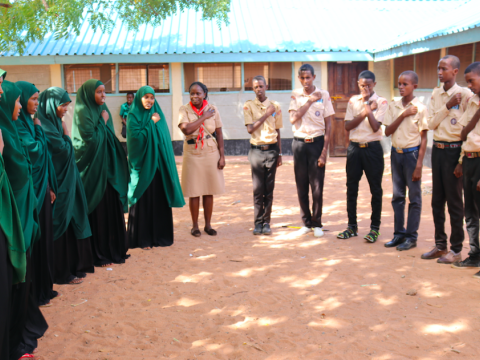Beyond borders and boundaries, Scouting embraces refugees worldwide

With more than 13 million children and youth under the age of 18 displaced from their homes and living as refugees around the world, the need for social and youth movements to mobilize and extend support to those in need has never been more critical.
How are youth and social movements around the world responding to the call?
As the world’s largest educational youth movement of over 50 million young people around the world, the Scout Movement has been working in difficult circumstances to create a welcoming environment for people of all backgrounds, integrating vulnerable communities, including refugees into its educational programmes and activities, through a large network of volunteers.
It is known that the rising figures of refugees is part of a global trend in the past few years which has seen more people displaced than at any other point in history. Recent conflicts in Syria, Democratic Republic of Congo (DRC), Myanmar, South Sudan and elsewhere have led to more than 70 million asylum-seekers, internally displaced people and refugees to relocate and seek safety.
In place after place, from Kenya’s Dadaab Refugee Camp to the Hatay province in southern Turkey, Scouts have welcomed refugees, migrants and displaced persons into Scouting as a way for young people to learn life skills, build self-confidence, and become leaders in their communities. In these places, Scouting is often the only form of education that young refugees receive.
“Scouting fills a gap that family and school do not. Scouts learn a set of skills that they do not necessarily learn in formal schooling such as how to interact with different communities, or how to lead and solve emerging problems,” said Mr. Nur, a Head Teacher at one of the primary schools in Dadaab Refugee Camp in Kenya.
In Kenya, Scouting has been introduced to the world’s largest refugee complex, Dadaab camp, since 2012, under a Scouting for Refugees programme that aims to support young refugees through education, skills development, community service and fun activities. Scouting is practiced in 22 primary and secondary schools in the massive camp, benefitting nearly 900 young refugees.
Further South in Dzaleka Camp in Malawi, over 200 young refugees joined the Scout unit that was started by young Scout leaders living there. Dzaleka Camp hosts refugees from Rwanda, Burundi and the DRC. Due to the limited space in the crowded camp schools, access to education is restricted and many refugees resort to Scouting as their only organized educational activity.
In Africa, along with Kenya and Malawi, Scouts have worked with thousands of refugees and provided humanitarian assistance in Uganda, Zambia, Cameroon and Burkina Faso where they collaborated with the UN Refugee Agency, UNHCR.
Scouting allows young refugees the opportunity to participate in many activities and trainings focused on peace-building and skills development. This leads many young Scouts to remain active in Scouting as they get older, volunteering as Scout Leaders to pass their knowledge and leadership on to a younger generation.
Aden, a 20-year-old young person living as a refugee in Dadaab Camp, joined Scouting when he was just 13-years-old and is now a unit leader and elected as a Camp Youth Leader.
“As leaders we organize different activities for youth around the camp, and focus on bringing children that have dropped out back to school,” said Aden. “I want people to know that Scouting brings hope and life changing opportunities to the people of Dadaab,” he shared.
Since the outbreak of Syria’s conflict in 2011, more than 6.7 million people have been forced to flee, the majority fled to nearby countries such as Turkey, Lebanon and Jordan. Scouts in these countries have started to integrate refugees into their programmes both inside and outside of refugee camps. In Turkey, Scouting has reached over 5,000 young boys and girls across Hatay province and other regions in both refugee camps and host communities, with ongoing plans to involve more young refugees this year.
The work of Scouts with refugees stretches across the Middle East in Lebanon, Jordan, Egypt and Tunisia and into Europe where Scouts have worked closely with refugee communities in transit sites in North Macedonia, and welcomed young refugees into Scouting in Greece, France, Austria, Germany and other European hosting countries. Here Scouts are volunteering at asylum centres, providing support for people on the move, contributing to relief work at camps, and integrating refugee children into existing Scout groups.

When conflict in Myanmar broke out, leading to an influx of 700,000 Rohingya refugees into Bangladesh, Scouts from Bangladesh worked together to provide immediate assistance to newly arrived refugee families, and expanded their efforts with orphaned refugees.
Scouting’s efforts with refugees are also reflected in South America, where Scouts in Brazil have established a programme integrating young refugees from Venezuela into their Scout units.
Due to the inclusivity of Scouting, young people from different ethnicities and communities work hand-in-hand, engaging in a wide range of activities together and building connections with one another. With a heavy emphasis on promoting peace and inclusion through dialogue, Scouting provides a safe environment to young people affected by conflict.
Through its Scouts for SDGs initiative and Messengers of Peace and a focus on Goals 10 and 16 to reduce inequalities and promote peace, Scouting is increasing its efforts to reach more communities who have been displaced to enable them to pursue sustainable livelihoods, and to ensure that every young person is given the opportunity to thrive.